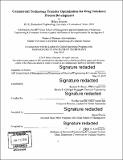| dc.contributor.advisor | Richard D. Braatz and Thomas Roemer. | en_US |
| dc.contributor.author | Doucette, Hillary. | en_US |
| dc.contributor.other | Sloan School of Management. | en_US |
| dc.contributor.other | Massachusetts Institute of Technology. Department of Electrical Engineering and Computer Science. | en_US |
| dc.contributor.other | Leaders for Global Operations Program. | en_US |
| dc.date.accessioned | 2019-10-11T22:25:08Z | |
| dc.date.available | 2019-10-11T22:25:08Z | |
| dc.date.copyright | 2019 | en_US |
| dc.date.issued | 2019 | en_US |
| dc.date.issued | 2019 | en_US |
| dc.identifier.uri | https://hdl.handle.net/1721.1/122594 | |
| dc.description | Thesis: M.B.A., Massachusetts Institute of Technology, Sloan School of Management, 2019, In conjunction with the Leaders for Global Operations Program at MIT | en_US |
| dc.description | Thesis: S.M., Massachusetts Institute of Technology, Department of Electrical Engineering and Computer Science, 2019, In conjunction with the Leaders for Global Operations Program at MIT | en_US |
| dc.description | Cataloged from PDF version of thesis. | en_US |
| dc.description | Includes bibliographical references (pages 69-72). | en_US |
| dc.description.abstract | Commercial technology transfer for biopharmaceuticals is the process of transferring process and product knowledge between process development and manufacturing organizations to achieve product realization. This process often occurs before phase 3 of clinical trials, where speed and agility are critical for preventing delays in clinical programs and ensuring commercial site readiness ahead of regulatory approval. As the market is evolving with new modalities and subsequent operational challenges, there is a heightened need to optimize the technology transfer process to sustain growth of products entering an organization's pipeline. This graduate research project seeks to understand the business process workflow of commercial tech transfer and characterize its dynamics using discrete event simulation. Through this quantitative technique of business process modeling, knowledge regarding process bottlenecks and system constraints were revealed, leading to the identification of operational efficiencies which suggest a potential 19.5% reduction in lead times and 31.3% increase in organizational capacity. Furthermore, this work provides a platform for predicting program timelines and resource needs based on preliminary transfer requirements. These predictions can be updated in a Bayesian fashion for real-time project scheduling and capacity planning. | en_US |
| dc.description.statementofresponsibility | by Hillary Doucette. | en_US |
| dc.format.extent | 72 pages | en_US |
| dc.language.iso | eng | en_US |
| dc.publisher | Massachusetts Institute of Technology | en_US |
| dc.rights | MIT theses are protected by copyright. They may be viewed, downloaded, or printed from this source but further reproduction or distribution in any format is prohibited without written permission. | en_US |
| dc.rights.uri | http://dspace.mit.edu/handle/1721.1/7582 | en_US |
| dc.subject | Sloan School of Management. | en_US |
| dc.subject | Electrical Engineering and Computer Science. | en_US |
| dc.subject | Leaders for Global Operations Program. | en_US |
| dc.title | Commercial technology transfer optimization for drug substance process development | en_US |
| dc.type | Thesis | en_US |
| dc.description.degree | M.B.A. | en_US |
| dc.description.degree | S.M. | en_US |
| dc.contributor.department | Sloan School of Management | en_US |
| dc.contributor.department | Massachusetts Institute of Technology. Department of Electrical Engineering and Computer Science | en_US |
| dc.contributor.department | Leaders for Global Operations Program | en_US |
| dc.identifier.oclc | 1119537637 | en_US |
| dc.description.collection | M.B.A. Massachusetts Institute of Technology, Sloan School of Management | en_US |
| dc.description.collection | S.M. Massachusetts Institute of Technology, Department of Electrical Engineering and Computer Science | en_US |
| dspace.imported | 2019-10-11T22:25:07Z | en_US |
| mit.thesis.degree | Master | en_US |
| mit.thesis.department | Sloan | en_US |
| mit.thesis.department | EECS | en_US |
